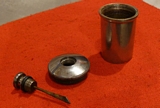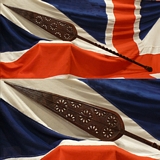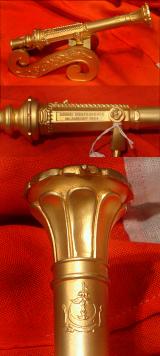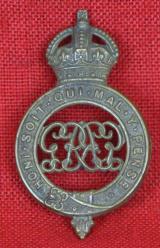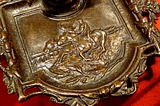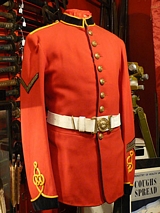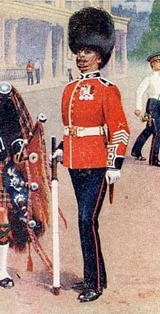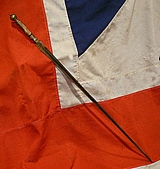A Good Original Antique Nickel G &JW Hawksley Gun Case Oil Bottle
19th century Ideal for all kinds of cased pistols or long guns. Excellent condition. 3cm across [at widest] 5.5cm inches high read more
105.00 GBP
A Beautiful Antique African Tribal Art Carved Paddle-Spear Possiblt From The Itsekiri PeopleOr Even Benin
In carved native wood with geometric carving and piercing. This is a dance paddle of the kind used in ceremonies by the Itsekiri people of the Niger delta. The river was at the centre of tribal society and economy – it provided food and transport for the communities who lived in the area. Canoes were an extremely important part of traditional society and so the paddle was an important symbol for prosperity. Local people relied on the river for their quality of life and believed in water spirits. This paddle is decorated with intricate carving and may have been used in ceremonial dances. Alternatively, it may have been made for trading with Europeans as ethnic objects became fashionable possessions. Although African, like Oceanic art it is often infused with ancestral spirits, as well as spirits of water, air and land. These spirits are contacted in ceremonies to ensure fertility, or invoke protection from famine, disease or enemies.
Sometimes these invocations serve extremely practical purposes. There was a ceremony in Papua New Guinea where ancestral spirits were activated in a carved wooden crocodile. Men carrying the crocodile were then led, like people holding a divining rod are led, to the home of a local murderer.
African and Oceanic art is not only made for decoration. It is made to be used as a tool in the culture. In the 20th century, Cubist painters, and especially Surrealists, were moved by the power of Oceanic abstractions, as they were by traditional African art. This wonderful piece would make a stunning additional display of object d’art in any setting, albeit traditional or contemporary read more
475.00 GBP
A Solid Gilt Bronze, Beautiful, Independence of Brunei 1984 Desk Cannon
In fine deluxe gilt finish, a modern representation of a an early Lantaka Cannon and Carriage, bearing the Royal Crest of the Sultan of Brunei. Especially commissioned for the Independence of Brunei in January 1984. Brunei, officially the Nation of Brunei, the Abode of Peace, it is a country located on the north coast of the island of Borneo in Southeast Asia. Apart from its coastline with the South China Sea, the country is completely surrounded by the insular Malaysian state of Sarawak. It is separated into two parts by the Sarawak district of Limbang. Brunei is the only sovereign state completely on the island of Borneo; the remainder of the island's territory is divided between the nations of Malaysia and Indonesia.. The government is an absolute monarchy under the Sultan, which implements a combination of English common law and sharia law, as well as direct general Islamic practices.
At the peak of the Bruneian Empire, Sultan Bolkiah (reigned 1485–1528) is alleged to have had control over most regions of Borneo, including modern-day Sarawak and Sabah, as well as the Sulu Archipelago off the northeast tip of Borneo, Seludong (modern-day Manila), and the islands off the northwest tip of Borneo. The maritime state was visited by Spain's Magellan Expedition in 1521 and fought against Spain in the 1578 Castilian War.
During the 19th century, the Bruneian Empire began to decline. The Sultanate ceded Sarawak (Kuching) to James Brooke and installed him as the White Rajah, and it ceded Sabah to the British North Borneo Chartered Company. In 1888, Brunei became a British protectorate and was assigned a British resident as colonial manager in 1906. After the Japanese occupation during World War II, in 1959 a new constitution was written. In 1962, a small armed rebellion against the monarchy was ended with the help of the British.
Brunei gained its independence from the United Kingdom on 1 January 1984. 28cm long read more
295.00 GBP
A King George Vth Die Struck Grenadier Guards Pagri Badge
The front has lost its gilt wash due to polishing, the rear has it remaining.The Regiment, as the Royal Regiment of Foot Guards, was formed in 1656 by King Charles the Second who was then in exile in Bruges, Flanders. It was known as the First Guards, later becoming the First Regiment of Foot Guards, and now bears the title "The First or Grenadier Regiment of Foot Guards" in honour or the defeat of the Grenadiers of the French Imperial Guard at the Battle of Waterloo in 1815.
It is the only Regiment in the British Army that has directly gained it's title from the part it played in action. As seen in all of Her Majesty The Queen's ceremonial occasions, such as Changing of The Guard and Trooping the Colour. read more
35.00 GBP
A Most Rare Large Aviation Medal For the Acceptance Run of the 'LZ 4'.Zeppelin
Medal 1908, by A. Galambos. On the acceptance run of the 'LZ 4'. Germania with sword in the right wreath medallion of Count Zeppelin under oak, right a crowd of faces in an auditorium and an airship above / winged male figure with torn chain over globe and cloud. Kaiser 292.3, Gutt 14
Obverse — Goddess Germania with Sword in right hand. 60 mm. They made a smaller 33 mm silver version, and a small undated bronze version 33mm but this is the very rare, large gilt bronze version, of 60mm
Dir/ Danken/ Deine/ Deutschen.
A. Galambos on bottom
inscription — 4. 5. August 1908 on the left. A. Galambos. The Zeppelin LZ 4 was a German experimental airship constructed under the direction of Ferdinand von Zeppelin. First flown on 20 June 1908, it made a series of successful flights including a 12-hour flight over Switzerland. It was destroyed when it caught fire after landing to carry out engine repairs during a projected 24-hour endurance trial.This disaster proved fortunate for Zeppelin: donations by the German public raised 6.5 million marks, so guaranteeing the future of his development of airships. . At Westfälische Auktionsgesellschaft
Auction 71, 29-30 April 2014, a much smaller silver more common version of this medal sold for 480 euro. read more
450.00 GBP
A Super, Antique Bronze Equestrian ' Horse Racing' Collectable
Ideal for the gentleman or lady with a passion for horse racing, horses or equine collectibles. In fine cast bronze, in the form of chamber stick. With a finely detailed relief design of a horse race, showing two race horses side by side with jockeys. With a mount for a matchbox, and a rear finger loop for holding and carrying. read more
275.00 GBP
All Now Sold +++Individual Illuminated Psalter Leaves, 12th to 13th Century
19 remaining Vellum leaves from a Psalter from the reign of King Philip Augustus (1179-1223), with burnished gold initials, from Northern France. Each leaf will be around £2,400 gbp. Twenty plus lines of the finest Gothic angular script on the recto and verso, decorated with initials adorned in gold leaf and pen work ornamentation
in red and blue tempera. Margins filled with floral scrolls, characters and stylized heads or grotesque. This was a way for the scribes of this period to add little individual touches to their work.
A part of the Psalm 73 to Psalm 76, then 79 to 84. Psalm 73 of the Book of Psalms is one of the "Psalms of Asaph"; it has been categorized as one of the Wisdom Psalms".
Probably produced in North-Eastern France, perhaps in the region around Soissons, Noyons, and Lyon, or at least certainly influenced by court productions of this area and manuscripts produced in Ile-de-France, especially those of Abbey St. Victor.
Although the original patron cannot be identified, the lavish use of gold leaf and high quality lead us to suspect that the work was possibly produced for a member of the court.
24 cm height x 16.75 cm width Sample example but generic photos. Email for further enquiries, we had 19 psalter pages remaining from the collection of 29 but all now sold. read more
Price
on
Request
A Very Good Pre WW1 Royal Engineer's Dress Uniform for Lance Corporal
Tunic and trousers. In excellent condition for age. Fine red cloth with single bullion corporal stripe . Fine original Royal Engineer buttons. Austrian knots and cuffs. British other ranks and NCO's uniforms made prior to WW1 are very sought after and so few survive today as to make them most scarce and very interesting. Makers label inside with date. read more
495.00 GBP
A Most Scarce WW1 Scot's Guardsman's Tunic, Part of The British Monarch’s Personal Guard
Tunic in traditional red with brass buttons. The centre regiment of the five Guards Regiments of the Household Div. The Scots Guards have over three hundred and sixty years of unbroken service to the crown. They can trace their origins back to an army that was raised by Archibald 1st Marquess of Argyll, 16 March 1642. Since this date the Regiment has served in nearly every campaign in which the British Army has been involved in. In 1686 they were brought onto the establishment of the English Army for the first time. Eight years later they took precedence within the Foot Guards, despite their seniority by length of service. The Battle Honours of the Regiment are;
Namur 1695, Dettingen, Lincelles, [Egypt]1, Talavera, Barrosa, Fuentes d?Onor, Salamanca, Nive, Peninsula, Waterloo, Alma, Inkerman, Sevastopol, Tel-el-Kebir, Egypt 1882, Suakin 1885, Modder River, South Africa 1899-1902
First World War: Retreat from Mons, Marne 1914, Aisne 1914, Ypres 1914 ?17, Langemarck 1914, Gheluvelt, Nonne Bosschen, Givenchy 1914, Neuve Chapelle, Aubers, Festubert 1915, Loos, Somme 1916 ?18, Flers-Courcelette, Morval, Pilckem, Poelcappelle, Passchendaele, Cambrai 1917 ?18, St. Quentin, Albert 1918, Bapaume 1918, Arras 1918, Drocourt-Qu?ant, Hindenburg Line, Havrincourt, Canal du Nord, Selle, Sambre, France and Flanders 1914-18
Second World War: Stien, Norway 1940, Mont Pincon, Quarry Hill, Estry, Venlo Pocket, Rhineland, Reichswald, Cleve, Moyland, Hochwald, Rhine, Lingen, Uelzen, North-West Europe 1944-45, Halfaya 1941, Sidi Suleiman, Tobruk 1941, Gazala, Knightsbridge, Defence of Alamein Line, Medenine, Tadjera Khir, Medjez Plain, Grich el Oued, Dejbel Bou Aoukaz 1943 I, North Africa 1941-43, Salerno, Battipaglia, Volturno Crossing, Roccheta e Croce, Monte Camino, Anzio, Campoleone, Carroceto, Trasimene Line, Advance to Florence, Monte San Michele, Catarelto Ridge, Argenta Gap, Italy 1943-45
Honours since the Second World War;
Tumbledown Mountain, Falkland Islands 1982, Gulf 1991 read more
465.00 GBP
An 18th Long, Boot or Cloak Sword
Cast brass hilt with relief figural decoration, and hawthorn wood grip. Steel rapier blade with engraving and deep fuller. Circa 1750. The knuckle bow and guard have been purposefully removed and the hilt re-attached. We had one quite similar, around 20 years ago, which came with an old article from a Connoisseur journal, It described, what was called, a boot or cloak sword. In the days of the threat by highwaymen, when a gentleman may have the need to consistently travel from town to town on horseback, but not by mail coach, a constant traveler might adapt a sword that could be easily slotted into knee high riding boots, or slipped into an especially constructed sleeve inside a riding cloak. For in wet and inclement weather a gentleman's flintlock pistol could not function, so without a sword for protection he was dangerously defenseless. Naturally a standard rapier short sword would be more normal, but on occasion, a gentleman that traveled constantly, or journeyed on perilous pursuits [such as a revenue man] might require a more concealable sword that would be far more easily manageable on both horseback or on foot. It also has the unique advantage of being eminently useable as a short distance spear type weapon, as it's weight balance is now very effective for that alternate purpose. 29.75 inches long overall read more
295.00 GBP


